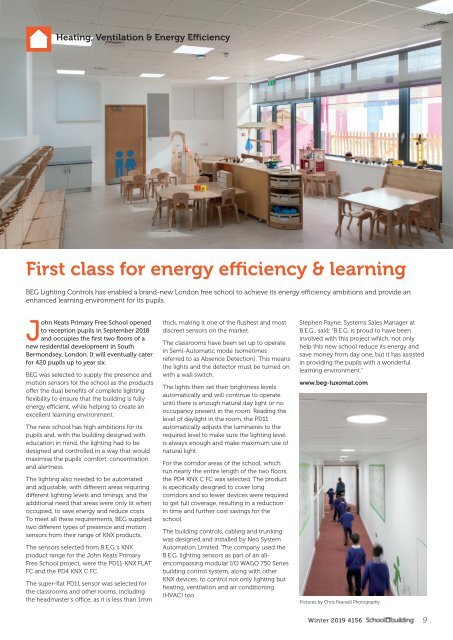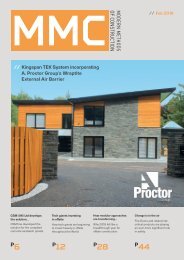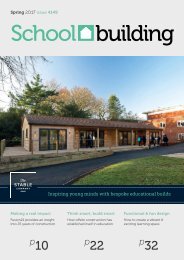SB 4156 32pp WEB
You also want an ePaper? Increase the reach of your titles
YUMPU automatically turns print PDFs into web optimized ePapers that Google loves.
Heating, Ventilation & Energy Efficiency<br />
First class for energy efficiency & learning<br />
BEG Lighting Controls has enabled a brand-new London free school to achieve its energy efficiency ambitions and provide an<br />
enhanced learning environment for its pupils.<br />
John Keats Primary Free School opened<br />
to reception pupils in September 2018<br />
and occupies the first two floors of a<br />
new residential development in South<br />
Bermondsey, London. It will eventually cater<br />
for 420 pupils up to year six.<br />
BEG was selected to supply the presence and<br />
motion sensors for the school as the products<br />
offer the dual benefits of complete lighting<br />
flexibility to ensure that the building is fully<br />
energy efficient, while helping to create an<br />
excellent learning environment.<br />
The new school has high ambitions for its<br />
pupils and, with the building designed with<br />
education in mind, the lighting had to be<br />
designed and controlled in a way that would<br />
maximise the pupils’ comfort, concentration<br />
and alertness.<br />
The lighting also needed to be automated<br />
and adjustable, with different areas requiring<br />
different lighting levels and timings, and the<br />
additional need that areas were only lit when<br />
occupied, to save energy and reduce costs.<br />
To meet all these requirements, BEG supplied<br />
two different types of presence and motion<br />
sensors from their range of KNX products.<br />
The sensors selected from B.E.G.’s KNX<br />
product range for the John Keats Primary<br />
Free School project, were the PD11-KNX FLAT<br />
FC and the PD4 KNX C FC.<br />
The super-flat PD11 sensor was selected for<br />
the classrooms and other rooms, including<br />
the headmaster’s office, as it is less than 1mm<br />
thick, making it one of the flushest and most<br />
discreet sensors on the market.<br />
The classrooms have been set up to operate<br />
in Semi-Automatic mode (sometimes<br />
referred to as Absence Detection). This means<br />
the lights and the detector must be turned on<br />
with a wall switch.<br />
The lights then set their brightness levels<br />
automatically and will continue to operate<br />
until there is enough natural day light or no<br />
occupancy present in the room. Reading the<br />
level of daylight in the room, the PD11<br />
automatically adjusts the luminaires to the<br />
required level to make sure the lighting level<br />
is always enough and make maximum use of<br />
natural light.<br />
For the corridor areas of the school, which<br />
run nearly the entire length of the two floors,<br />
the PD4 KNX C FC was selected. The product<br />
is specifically designed to cover long<br />
corridors and so fewer devices were required<br />
to get full coverage, resulting in a reduction<br />
in time and further cost savings for the<br />
school.<br />
The building controls, cabling and trunking<br />
was designed and installed by Neo System<br />
Automation Limited. The company used the<br />
B.E.G. lighting sensors as part of an allencompassing<br />
modular I/O WAGO 750 Series<br />
building control system, along with other<br />
KNX devices, to control not only lighting but<br />
heating, ventilation and air conditioning<br />
(HVAC) too.<br />
Stephen Payne, Systems Sales Manager at<br />
B.E.G., said: “B.E.G. is proud to have been<br />
involved with this project which, not only<br />
help this new school reduce its energy and<br />
save money from day one, but it has assisted<br />
in providing the pupils with a wonderful<br />
learning environment.”<br />
www.beg-luxomat.com<br />
Pictures by Chris Pearsall Photography.<br />
Winter 2019 <strong>4156</strong> 9
















